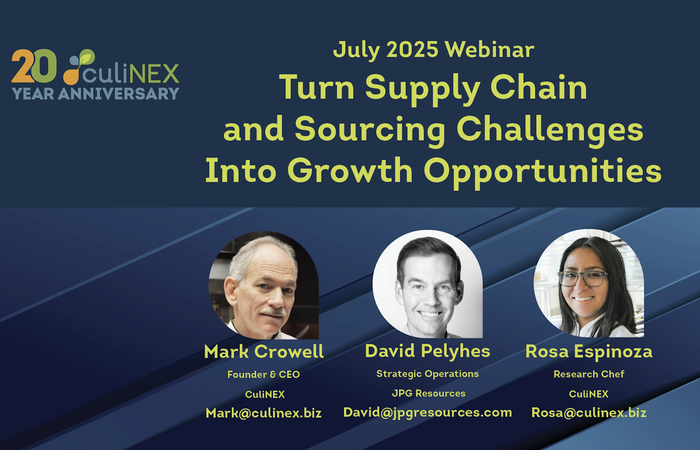
In today’s unpredictable supply landscape, CuliNEX has created a new monthly free webinar series to help Consumer Packaged Goods (CPG) food and beverage brands respond to a range of rising challenges. The kickoff discussion in July 2025 addressed an issue that’s key to CPG brand success today: sourcing and supply chain issues.
If the issues of ingredient shortages, price increases, and tariffs are key to your brand’s success, reach out to CuliNEX today to speak with an expert for support with formulation, sourcing, and ingredient vetting.
This month’s expert panel included Rosa Espinoza, Research Chef at CuliNEX and David Pelyhes, Business Partner at JPG Resources. CuliNEX founder Mark Crowell took on the moderator duties. The three panelists had a lively discussion exploring best practices for responding to disruptions in the supply chain, whether those interruptions come from ingredient shortages, price increases, or tariffs.
Are reformulation issues important to your brand’s success? Register now for next month’s free webinar, "The Science of Compliance: Reformulating Food Products for Regulatory Success"
When Ingredients Become Scarce, Reformulate
Brands face some difficult decisions when a key ingredient becomes hard to find. “If it’s unavailable or scarce, it’s all hands on deck,” said David Pelyhes, the procurement and supply chain leader at JPG Resources. In these instances, a brand must have a clear understanding of its priorities. Priority number one is continuity. “When a key ingredient becomes unavailable,” said Pelyhes, “keeping the brand on the shelf is primary.”
The ideal approach when sourcing alternative ingredients is to make a “like-for-like” ingredient swap that preserves the functionality of the product. During the 2021 starch shortage, for example, Pelyhes and his team executed iterative starch substitutions over several months. This was an essential effort that allowed the brand to remain on shelf.
Understanding the Disruption
Supply disruptions come in many forms. So, it’s important to gain a clear sense of the larger sourcing environment and timeframe. Short-term shortages (like vanilla or cocoa) are easier to spot and manage. But structural changes, such as shifts in logistics or increased inventory levels, require more strategic observation.
Other changes can’t easily be categorized and require monitoring. As an example, Pelyhes points out the seed oil market. “Are changes in seed oil a megatrend or a fad?” asked Pelyhes. “We don’t know yet—but smart brands are watching closely.”
Seed oil is widely used in consumer baked goods, snacks, condiments, and prepared meals. “This is such a great example,” said Mark Crowell, founder of CuliNEX. “This one product category is being impacted by the war in Ukraine, the MAHA movement in social media. and politics in the White House.”
The Effect of Ingredient Pricing Changes
Scarcity may not be the only reason to reformulate. Costs are an important factor, too. When an ingredient’s pricing is on a rising trajectory, is it time to formulate? Cost spikes happen, but not every cost increase demands reformulation.
Companies with ongoing cost optimization programs are best positioned to analyze these shifts calmly and methodically. Pelyhes advises watching for a 2%–3% gross margin impact as the trigger point for reformulation.
He pointed to the 2021 starch shortage as a case study. Over five months, his team iterated multiple starch swaps to keep a product on shelf without changing the ingredient label or losing consumer trust.
Procurement goes hand in hand with development. Constantly review the sourcing horizon. Keep your sourcing team in close communication with your development team. Organizations must include ingredient sourcing as part of a brand’s larger strategic plan, as opposed to considering it a simple functional chore.
Respond Methodically to Tariffs
When it comes to the effect of tariffs on the supply chain, Pelyhes offers this simple notion: don’t overreact. Reformulating in response to tariff changes can be costly.
To effectively determine sourcing changes, Pelyhes recommends:
- Verifying HTS codes and countries of origin
- Using experienced brokers
- Building tariff sensitivity into your cost model
Relationships Matter—Especially Before the Crisis
Panelist Rosa Espinoza stressed the value of building strong supplier relationships. This can lead to a wider set of options during times of change. For example, with a good relationship, you may be able to leverage your co-man’s existing ingredient inventory. “If they’ve already vetted a supplier, that’s a shortcut,” said Espinoza. “I still test it, of course—but it’s a huge confidence boost if I recognize the brand or have used it in another project.”
It’s important to build supplier relationships well before a crisis hits. “It’s not just about a friendly smile at a trade show. It’s about honesty, transparency, and consistency,” said Espinoza. She emphasized the value of sharing feedback, both positive and negative, with vendors. Something as simple as telling a supplier their ingredient won’t be used (rather than ghosting them) builds trust and sets the stage for future collaboration. “I keep vendors in the loop, even if we’re not moving forward,” she said. “That honesty builds trust—and gives them a chance to pivot and improve.”
A strong relationship means sharing both wins and challenges with suppliers and cultivating an ongoing feedback loop that pays dividends when things get tight.
3 Takeaways
CPG Brands today need flexibility, strong relationships, and innovation to succeed today. The brands that can successfully reformulate are those who:
- Invest in building supplier relationships
- Align procurement with development, constantly analyze the sourcing horizon
- Treat ingredient sourcing as a strategic lever, not a tactical chore
If your brand needs support with formulation, sourcing, or ingredient vetting, reach out to the team at CuliNEX to help you reformulate—without compromising the qualities that make your brand unique.








